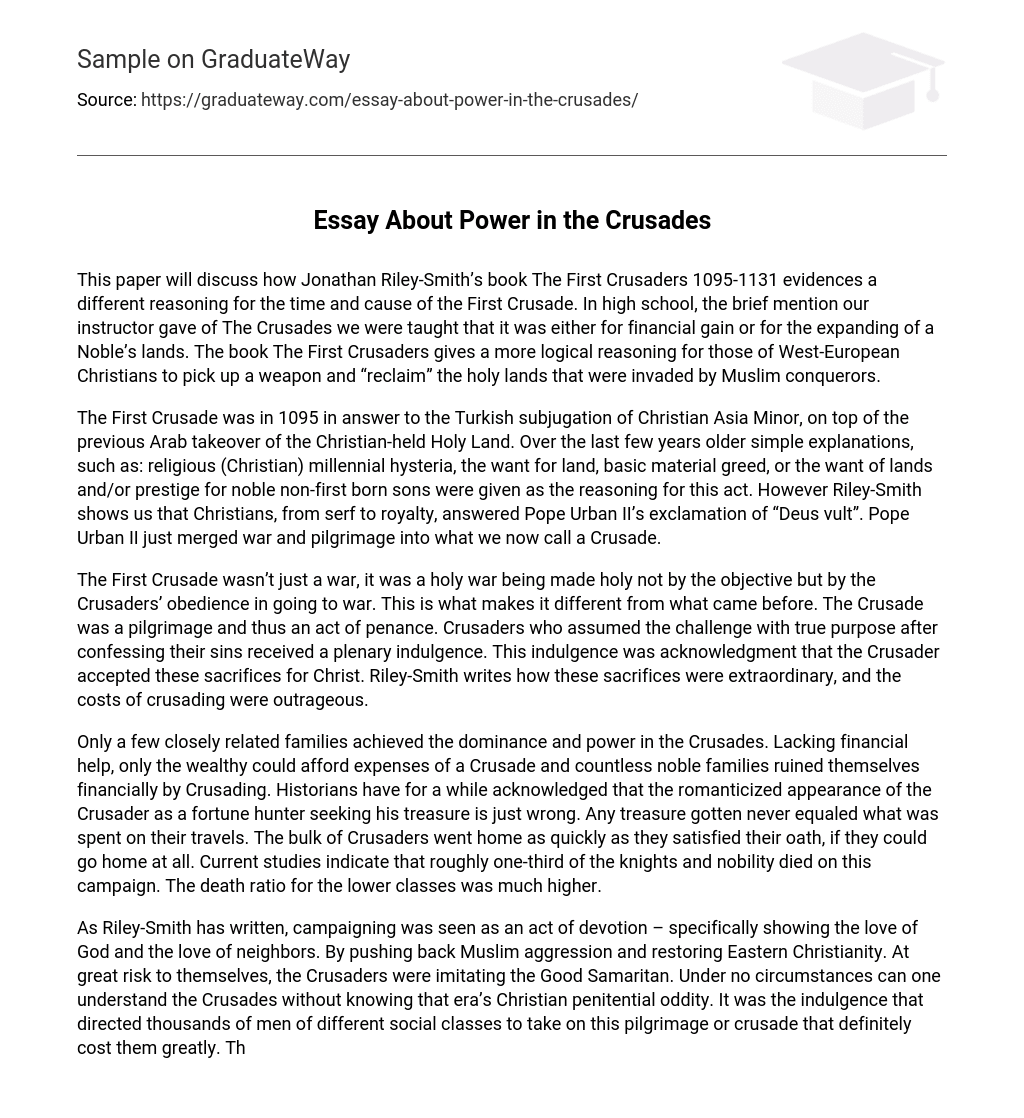This paper will discuss how Jonathan Riley-Smith’s book The First Crusaders 1095-1131 evidences a different reasoning for the time and cause of the First Crusade. In high school, the brief mention our instructor gave of The Crusades we were taught that it was either for financial gain or for the expanding of a Noble’s lands. The book The First Crusaders gives a more logical reasoning for those of West-European Christians to pick up a weapon and “reclaim” the holy lands that were invaded by Muslim conquerors.
The First Crusade was in 1095 in answer to the Turkish subjugation of Christian Asia Minor, on top of the previous Arab takeover of the Christian-held Holy Land. Over the last few years older simple explanations, such as: religious (Christian) millennial hysteria, the want for land, basic material greed, or the want of lands and/or prestige for noble non-first born sons were given as the reasoning for this act. However Riley-Smith shows us that Christians, from serf to royalty, answered Pope Urban II’s exclamation of “Deus vult”. Pope Urban II just merged war and pilgrimage into what we now call a Crusade.
The First Crusade wasn’t just a war, it was a holy war being made holy not by the objective but by the Crusaders’ obedience in going to war. This is what makes it different from what came before. The Crusade was a pilgrimage and thus an act of penance. Crusaders who assumed the challenge with true purpose after confessing their sins received a plenary indulgence. This indulgence was acknowledgment that the Crusader accepted these sacrifices for Christ. Riley-Smith writes how these sacrifices were extraordinary, and the costs of crusading were outrageous.
Only a few closely related families achieved the dominance and power in the Crusades. Lacking financial help, only the wealthy could afford expenses of a Crusade and countless noble families ruined themselves financially by Crusading. Historians have for a while acknowledged that the romanticized appearance of the Crusader as a fortune hunter seeking his treasure is just wrong. Any treasure gotten never equaled what was spent on their travels. The bulk of Crusaders went home as quickly as they satisfied their oath, if they could go home at all. Current studies indicate that roughly one-third of the knights and nobility died on this campaign. The death ratio for the lower classes was much higher.
As Riley-Smith has written, campaigning was seen as an act of devotion – specifically showing the love of God and the love of neighbors. By pushing back Muslim aggression and restoring Eastern Christianity. At great risk to themselves, the Crusaders were imitating the Good Samaritan. Under no circumstances can one understand the Crusades without knowing that era’s Christian penitential oddity. It was the indulgence that directed thousands of men of different social classes to take on this pilgrimage or crusade that definitely cost them greatly. The lay aristocracy of medieval Europe was warrior nobility, making their living by the sword. Riley-Smith shows from their wills and charters that they intensely knew their own impiety, and were concerned over the state of their souls. A Crusade delivered an opportunity for them to serve God and atone for their sins. It permitted them to use these same weapons as for their deliverance rather than for their damnation to hell.
The 11th Century Roman Catholic Church claimed that its motives for the First Crusade was sacred, based solely on religious principles. Pope Urban II still made it a point to use theatrics and play to his audience of warriors-caste to excite knights into going to fight in the eastern lands held by the Muslims (57). When Urban II called the First Crusade in 1095, he formed an ideal that was used for centuries. The parallelism of a Crusaders sacrifice to that of Christ, the penitence, and the issuance of indulgences were a combination that many western European men couldn’t refuse.
Jonathan Riley-Smith admittedly uses a computer database built for him in 1987. Entering information from various charters, old legal paperwork, clerical sources, and other sources allow him to categorize historical information to where it is much easier accessed and processed. In doing this he originally was trying to find information on why men and women “took the cross” (01) and yet only a few families that did prosper from the First Crusade. He amassed enough information to where he started having a few new questions and this book is the result.
The book The First Crusaders 1095-1131 definitely shows Riley Smith can prove a point. In this book he shows where a large majority of the Crusaders did not profit in their expeditions to the Holy Lands. He shows where many of the warrior class weren’t expecting to profit in a physical sense. The wars temporarily removed Muslim rule from much of once Christian lands which was the objective of what they were there for in the first place.





